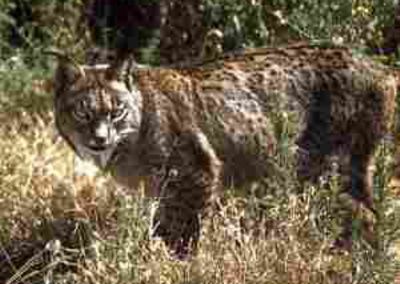
Profile by Phil Crosby
Iberian Lynx
Lynx pardinus
 |
| Iberian lynx photo from the BBC |
|---|
The Lynx is a distinctive looking cat, which is readily identified by its short tail. There are four species, the Eurasian Lynx (Lynx lynx), the Canadian Lynx (Lynx canadensis),the Iberian Lynx (Lynx pardinus) and the Bobcat or Red Lynx (Lynx rufus). Of these the Eurasian was resident in Britain until historic times (and some believe it may never have become completely extinct), the Canadian is a cat which may have been released into the wild either accidentally or deliberately. The Iberian Lynx is perhaps the rarest big cat species in the world, numbering fewer than 500 in the wild, and as such is unlikely to be encountered in the UK.
Life span
Iberian lynx live for up to 13 years in the wild.
Statistics
Body length: 75-100 cm, Tail length: 12-13 cm, Shoulder height: 45-70 cm, Weight: up to 18 kg.
Physical Description
Spanish lynx have a brownish-grey to yellowish red coat, with sharply contrasting black spots and stripes, and a white underside. They have long tufts on their ears and very long whiskers. Spanish lynx are smaller than Eurasian lynx.
Distribution
Spanish lynx formally occurred throughout the Iberian Peninsula but are now restricted to scattered mountainous areas and the Guadalquivir Delta.
Habitat
They inhabit open forests and thickets.
Diet
Wild rabbits are their main prey, but they also hunt other small mammals and birds.
Behaviour
Lynx are shy and solitary, except for mothers with cubs. They mark their territories by urinating on trees and rocks. Male territories can overlap several female territories. Females usually have one mate per season, but males may have more than one.
Spanish lynx are active at night. They stay active in winter and their fur becomes thicker and paler. In extreme weather, they take shelter in caves or trees.
Lynx bury any uneaten prey and return the next day to finish it off.
 |
 |
 |
| Return to index | Return to Scottish Big Cats | Return to Identification |